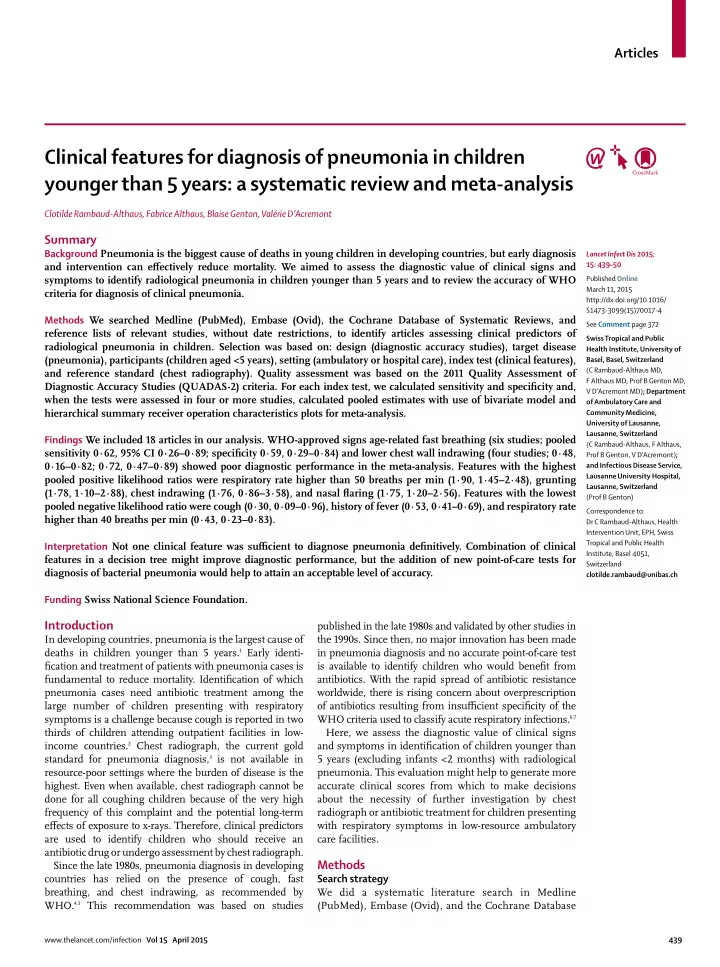

Articles Clinical features for diagnosis of pneumonia in children younger than 5 years: a systematic review and meta-analysis Clotilde Rambaud-Althaus, Fabrice Althaus, Blaise Genton, Valérie D’Acremont Summary Background Pneumonia is the biggest cause of deaths in young children in developing countries, but early diagnosis Lancet Infect Dis 2015; and intervention can eff ectively reduce mortality. We aimed to assess the diagnostic value of clinical signs and 15: 439–50 symptoms to identify radiological pneumonia in children younger than 5 years and to review the accuracy of WHO Published Online March 11, 2015 criteria for diagnosis of clinical pneumonia. http://dx.doi.org/10.1016/ S1473-3099(15)70017-4 Methods We searched Medline (PubMed), Embase (Ovid), the Cochrane Database of Systematic Reviews, and See Comment page 372 reference lists of relevant studies, without date restrictions, to identify articles assessing clinical predictors of Swiss Tropical and Public radiological pneumonia in children. Selection was based on: design (diagnostic accuracy studies), target disease Health Institute, University of (pneumonia), participants (children aged <5 years), setting (ambulatory or hospital care), index test (clinical features), Basel, Basel, Switzerland (C Rambaud-Althaus MD, and reference standard (chest radiography). Quality assessment was based on the 2011 Quality Assessment of F Althaus MD, Prof B Genton MD, Diagnostic Accuracy Studies (QUADAS-2) criteria. For each index test, we calculated sensitivity and specifi city and, V D’Acremont MD) ; Department when the tests were assessed in four or more studies, calculated pooled estimates with use of bivariate model and of Ambulatory Care and hierarchical summary receiver operation characteristics plots for meta-analysis. Community Medicine, University of Lausanne, Lausanne, Switzerland Findings We included 18 articles in our analysis. WHO-approved signs age-related fast breathing (six studies; pooled (C Rambaud-Althaus, F Althaus, sensitivity 0·62, 95% CI 0·26–0·89; specifi city 0·59, 0·29–0·84) and lower chest wall indrawing (four studies; 0·48, Prof B Genton, V D’Acremont) ; 0·16–0·82; 0·72, 0·47–0·89) showed poor diagnostic performance in the meta-analysis. Features with the highest and Infectious Disease Service, Lausanne University Hospital, pooled positive likelihood ratios were respiratory rate higher than 50 breaths per min (1·90, 1·45–2·48), grunting Lausanne, Switzerland (1·78, 1·10–2·88), chest indrawing (1·76, 0·86–3·58), and nasal fl aring (1·75, 1·20–2·56). Features with the lowest (Prof B Genton) pooled negative likelihood ratio were cough (0·30, 0·09–0·96), history of fever (0·53, 0·41–0·69), and respiratory rate Correspondence to: higher than 40 breaths per min (0·43, 0·23–0·83). Dr C Rambaud-Althaus, Health Intervention Unit, EPH, Swiss Tropical and Public Health Interpretation Not one clinical feature was suffi cient to diagnose pneumonia defi nitively. Combination of clinical Institute, Basel 4051, features in a decision tree might improve diagnostic performance, but the addition of new point-of-care tests for Switzerland diagnosis of bacterial pneumonia would help to attain an acceptable level of accuracy. clotilde.rambaud@unibas.ch Funding Swiss National Science Foundation. Introduction published in the late 1980s and validated by other studies in In developing countries, pneumonia is the largest cause of the 1990s. Since then, no major innovation has been made deaths in children younger than 5 years. 1 Early identi- in pneumonia diagnosis and no accurate point-of-care test fi cation and treatment of patients with pneumonia cases is is available to identify children who would benefi t from fundamental to reduce mortality. Identifi cation of which antibiotics. With the rapid spread of antibiotic resistance pneumonia cases need antibiotic treatment among the worldwide, there is rising concern about overprescription large number of children presenting with respiratory of antibiotics resulting from insuffi cient specifi city of the symptoms is a challenge because cough is reported in two WHO criteria used to classify acute respiratory infections. 6,7 thirds of children attending outpatient facilities in low- Here, we assess the diagnostic value of clinical signs income countries. 2 Chest radiograph, the current gold and symptoms in identifi cation of children younger than standard for pneumonia diagnosis, 3 is not available in 5 years (excluding infants <2 months) with radiological resource-poor settings where the burden of disease is the pneumonia. This evaluation might help to generate more highest. Even when available, chest radiograph cannot be accurate clinical scores from which to make decisions done for all coughing children because of the very high about the necessity of further investigation by chest frequency of this complaint and the potential long-term radiograph or antibiotic treatment for children presenting eff ects of exposure to x-rays. Therefore, clinical predictors with respiratory symptoms in low-resource ambulatory are used to identify children who should receive an care facilities. antibiotic drug or undergo assessment by chest radiograph. Methods Since the late 1980s, pneumonia diagnosis in developing countries has relied on the presence of cough, fast Search strategy breathing, and chest indrawing, as recom mended by We did a systematic literature search in Medline WHO. 4,5 This recommendation was based on studies (PubMed), Embase (Ovid), and the Cochrane Database www.thelancet.com/infection Vol 15 April 2015 439
Recommend
More recommend